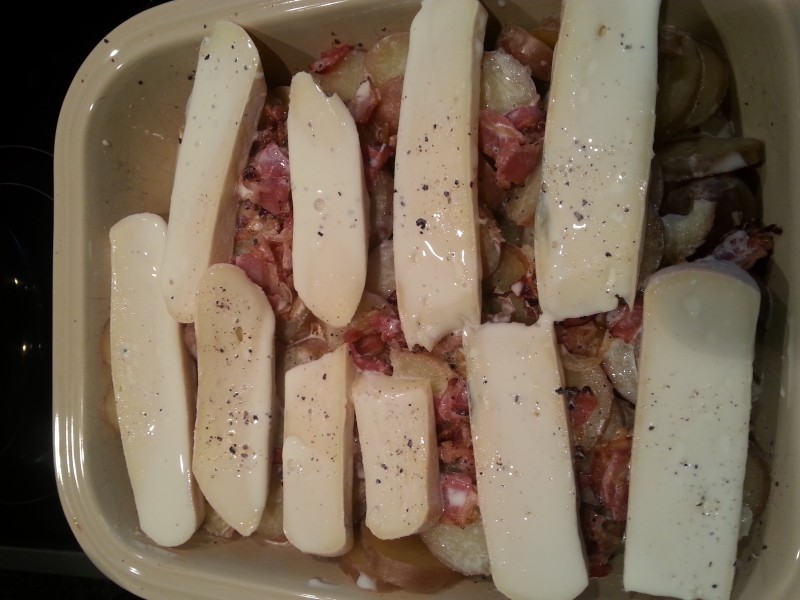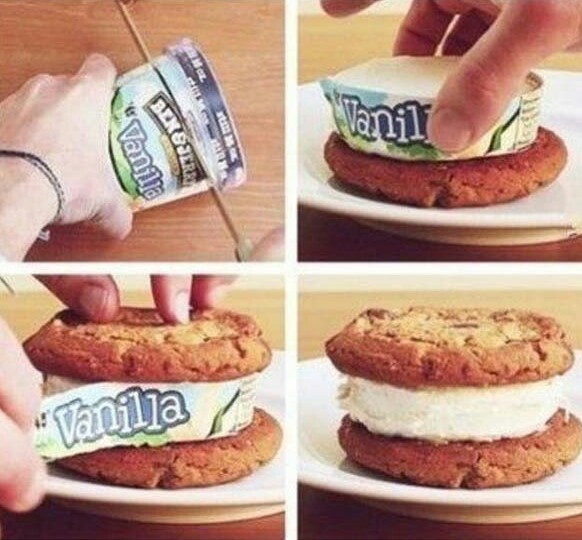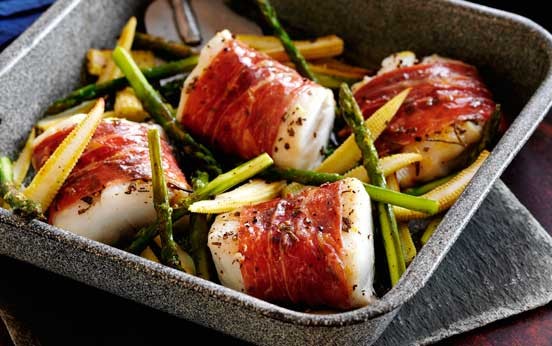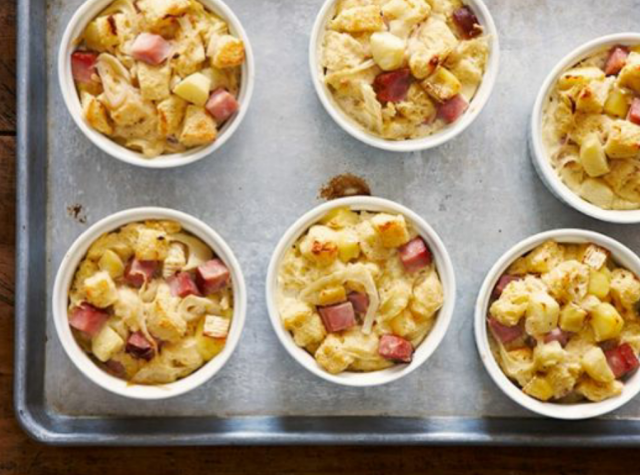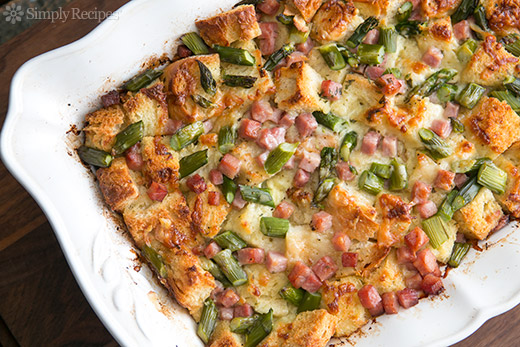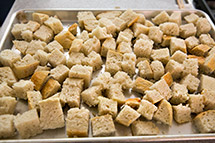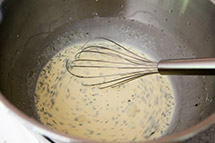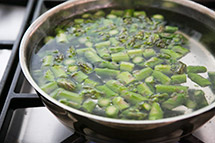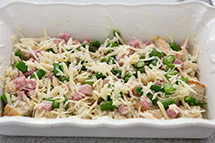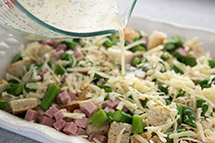With waffles!
Tag: recipes
[recipe] homemade cereal bars
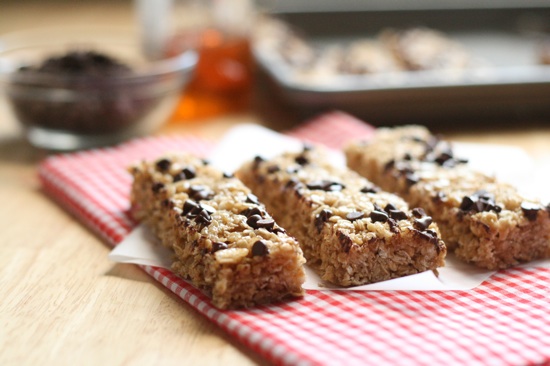
1. Base Ingredient: 2 1/2 Cups, Total, of any of the following:
Quick cooking oats, Puffed wheat, Rice Crispies, Special K
2. Something Sweet: 3/4 Cups of any combination of the following:
Honey, Grade B Maple Syrup, Molasses, Agave or other sweetener.
3. Something Chewy: 1 Cup of any or all of the below:
Dried Cranberries, Raisins, Apricots, Dates, Pineapple, Figs, Cherries, Blueberries etc. (Just keep the size of the fruit relatively small (ie, diced if larger, like dates).
4. Something Crunchy: 1 Cup of any.
Sunflower Seeds, Chocolate Chips, Cocoa nibs, other seeds or nuts (if possible)
5. Something to Hold it All Together: 1 Cup
Try using Applesauce, Peanut Butter, Almond Butter, Pureed Dates, Nutella, Biscoff Spread, etc. (again, avoid peanut butter if sending these to school).
1. Heat Oven to 325F/ 170C/ 150fan.
2. Line an 8×8 Baking pan with parchment paper in cross-wise fashion with lots of extra overhanging.
3. Mix dry ingredients together in a large bowl. (ie. base, chewy, crunchy). Add spice to taste. (ex cinnamon, clove, nutmeg, 1 tsp salt).
4. Mix wet ingredients together. ( ie. sweet, and something to hold it all together, 1 tsp vanilla extract).
5. Combine wet into dry, and mix well.
6. Pour mixture into baking pan, and with the extra parchment paper overhanging, press mixture firmly and evenly in pan. When you think you’ve pressed it firmly enough, do it again and press a little more.
7. Bake for 25 minutes. Remove from oven, and let cool for 2 hours. Remove from pan and cut into desired size (squares or bars).
You can store these in an airtight container for 5-6 days. (if they last that long!)
[recipe] Beef Wellington
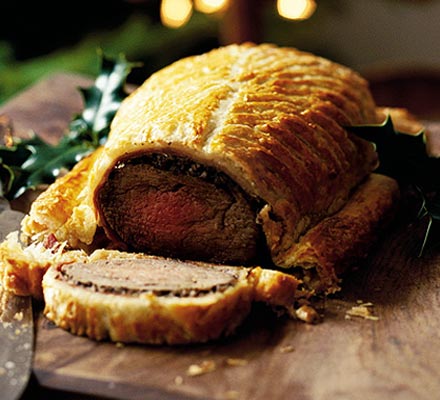
A good beef fillet (preferably Aberdeen Angus) of around 1kg
3 tbsp olive oil
250g chestnut mushroom, include some wild ones if you like
50g butter
1 large sprig fresh thyme
100ml oz dry white wine
12 slices prosciutto
500g pack puff pastry, thawed if frozen
a little flour, for dusting
2 egg yolks beaten with 1 tsp water
Dijon mustard
1. Heat oven to 200C/fan 180C/gas 7. Pan sear the beef in olive oil to give it some colour. Season with salt and pepper. Transfer to the oven and roast for 15 mins for medium-rare or 20 mins for medium. When the beef is cooked to your liking, remove from the oven to cool, then chill in the fridge for about 20 mins.
2. While the beef is cooling, chop 250g chestnut (and wild, if you like) mushrooms as finely as possible so they have the texture of coarse breadcrumbs. You can use a food processor to do this, but make sure you pulse-chop the mushrooms so they don’t become a slurry.
3. Heat 2 tbsp of the olive oil and 50g butter in a large pan and fry the mushrooms on a medium heat, with 1 large sprig fresh thyme, for about 10 mins stirring often, until you have a softened mixture. Season the mushroom mixture, pour over 100ml dry white wine and cook for about 10 mins until all the wine has been absorbed. The mixture should hold its shape when stirred. Remove the mushroom duxelle from the pan to cool and discard the thyme.
4. Overlap two pieces of cling film over a large chopping board. Lay 12 slices prosciutto on the cling film, slightly overlapping, in a double row. Spread half the duxelles over the prosciutto, then sit the fillet on it. Brush Dijon mustard on the beef filet with a pastry brush and spread the remaining duxelles over. Use the cling film’s edges to draw the prosciutto around the fillet, then roll it into a sausage shape, twisting the ends of cling film to tighten it as you go. Chill the fillet while you roll out the pastry.
5. Dust your work surface with a little flour. Roll out a third of the 500g pack of puff pastry to a 18 x 30cm strip and place on a non-stick baking sheet. Roll out the remainder of the 500g pack of puff pastry to about 28 x 36cm. Unravel the fillet from the cling film and sit it in the centre of the smaller strip of pastry. Beat the 2 egg yolks with 1 tsp water and brush the pastry’s edges, and the top and sides of the wrapped fillet. Using a rolling pin, carefully lift and drape the larger piece of pastry over the fillet, pressing well into the sides. Trim the joins to about a 4cm rim. Seal the rim with the edge of a fork or spoon handle. Glaze all over with more egg yolk and, using the back of a knife, mark the beef Wellington with long diagonal lines taking care not to cut into the pastry. Chill for at least 30 mins and up to 24 hrs.
Heat oven to 200C/fan 180C/gas 6. Brush the Wellington with a little more egg yolk and cook until golden and crisp – 20-25 mins for medium-rare beef, 30 mins for medium. Allow to stand for 10 mins before serving in thick slices.
Alternatives: You can replace the prosciutto with a generous slathering of paté. You can also mix in some Boursin cheese with the mushroom duxelle.
[recipe] Easiest pork ribs in the world
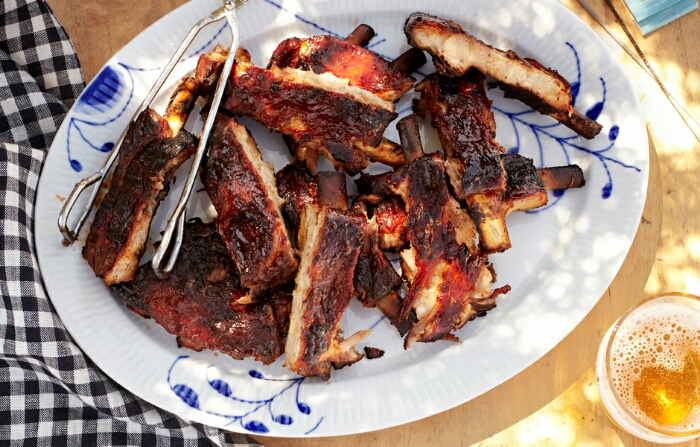
INGREDIENTS
2 1/2 tablespoons kosher salt
1 tablespoon dry mustard
1 tablespoon paprika
1/2 teaspoon cayenne pepper
1/2 teaspoon freshly ground black pepper
8 pounds baby back pork ribs (8 racks)
Low-salt chicken broth (optional)
1 1/2 cups store-bought or homemade bbq sauce
PREPARATION
Preheat oven to 350F/175C. Combine first 5 ingredients in a small bowl. Place each rack of ribs on a double layer of foil; sprinkle rub all over ribs. Wrap racks individually and divide between 2 baking sheets.
Bake ribs until very tender but not falling apart, about 2. Carefully unwrap ribs; pour any juices from foil into a 4-cup heatproof measuring cup; reserve juices. Let ribs cool completely. DO AHEAD: Ribs can be baked up to 3 days ahead (the flavor will be more developed, and the cold ribs will hold together better on the grill as they heat through). Cover and chill juices. Rewrap ribs in foil and chill.
Build a medium-hot fire in a charcoal grill, or heat a gas grill to high. Add broth or water to rib juices, if needed, to measure 1 1/2 cups. Whisk in barbecue sauce to blend.
Grill ribs, basting with barbecue sauce mixture and turning frequently, until lacquered and charred in places and heated through, 7-10 minutes. Transfer to a cutting board; cut between ribs to separate. Transfer to a platter and serve with additional barbecue sauce.
[recipe] roast cod wrapped in parma ham
Preheat the oven to 180C/350F/Gas 4.
Cut out four squares of greaseproof paper, approximately 25cm/10in x 25cm/10in in size, and lay two slices of ham on each piece of paper to overlap.
Lay a cod fillet on top of each pair. Season with salt and pepper. Coat with preferred topping*. Roll up the paper around each fillet to make a cigar-shaped parcel and carefully remove the paper from each piece of wrapped cod.
Place the parcels onto a lightly oiled baking tray. Roast for 15-20 minutes until cooked all the way through. Serve at once.
* suggested toppings:
– Red pepper pesto
– Maille dill and lime mustard
– Sundried tomato and basil tapenade
– Lemon zest and rosemary
[recipe] Brie and ham bread and butter pudding
Ingredients
3 tablespoons unsalted butter, plus more for the ramekins
450g camembert cheese with rind
400ml single cream
400ml full fat milk
4 large eggs
Kosher salt and freshly ground black pepper
1 baguette, bottom crust discarded, cut into 1/2-inch dice
450g cooked, smoked ham, cut into 1/2-inch cubes
2 shallots, thinly sliced
2 large fresh thyme sprigs
1 Granny Smith apple, peeled, cored and cut into 1/2-inch cubes
1 cup dry white wine
Green salad, for serving, optional
Directions
Preheat the oven to 375 degrees F with 1 rack set on the middle shelf and 1 rack set on the bottom shelf. Fill a large baking dish halfway with warm water and place on the bottom rack.
Butter eight 8-ounce ramekins and place on a baking sheet. Slice the cheese into 1/2-inch cubes and lay on a plate to keep them from sticking together.
Whisk the cream and eggs together in a large bowl. Add 1 teaspoon salt and a pinch of pepper. Add the baguette cubes and ham. Stir to combine.
Melt the butter in a large saute pan over medium-high heat. Add the shallots and thyme, season with salt and pepper and cook until slightly softened and browned around the edges, 4 to 6 minutes. Add the apples, season with salt and pepper and cook until slightly softened and browned around the edges, 3 to 5 minutes. Stir in the wine and cook until the wine has completely absorbed, 3 to 4 minutes. Discard the thyme sprigs. Add the apple mixture along with the cheese cubes to the beaten eggs, and stir to combine.
Evenly divide the bread pudding among the ramekins. Bake until a paring knife inserted into the center of a bread pudding comes out clean and hot, 18 to 25 minutes, rotating the pan halfway through. Allow the bread puddings to cool for at least 5 minutes before serving. Serve alongside a lightly dressed green salad.
[recipe] Asparagus Ham Strata
This ham and asparagus strata is basically a breakfast casserole, taken up a notch or two. It’s a layered casserole with cubes of rustic bread, eggs, Gruyere cheese, milk, cream, diced ham, and asparagus.
It feeds a crowd. You can easily make ahead. Leftovers (if you have them, which I seriously doubt) will reheat beautifully for days.
INGREDIENTS
1 loaf Italian or French rustic bread, cut into 1 1/2-inch cubes, about 8 cups total of bread cubes
1 pound asparagus spears, woody ends removed, spears cut into 3/4-inch pieces
Salt (for blanching water)
1 medium bowl of ice water
2 Tbsp softened butter (for buttering the dish)
6-ounces ham, cut into 1/4-inch cubes, about 2 cups
4-ounces Gruyere cheese, grated, about 1 cup, packed
4 eggs
1 1/4 cups cream
1 3/4 cups milk
1 teaspoon salt
1 teaspoon dried tarragon (or thyme)
1/4 teaspoon ground black pepper
METHOD
1. Preheat the oven to 400F. Spread the cubed bread over a baking dish or sheet pan in a single layer. Place in oven and bake until lightly toasted, about 7 to 8 minutes. Remove and set aside. Lower the oven temperature to 350F.
2. In a large bowl, whisk together the eggs, milk, cream, salt, pepper, and tarragon. Set aside.
3. Bring 2 quarts of salted water to a boil (1 1/2 teaspoons of salt). Add the cut asparagus to the boiling water. Return to a boil and blanch the asparagus for 2 to 3 minutes. Remove the asparagus to a bowl of ice water to shock the asparagus and stop the cooking. Drain and set aside.
4. Spread butter over the inside of a 8x11x2 inch casserole dish. Spread half of the bread cubes over the bottom of the casserole dish. Sprinkle half of the ham cubes over the bread. Sprinkle half of the asparagus over the ham. Sprinkle everything with half of the Gruyere cheese. Pour half of the milk egg mixture over everything.
5. Repeat the process. Add another layer of cubed bread, ham, asparagus, Gruyere, and milk egg mixture. Press down on the mixture with your (clean) hands to help the bread soak up more of the milk mixture. (At this point you can make up to a day ahead, cover and refrigerate until ready to cook.)
6. Cover with aluminum foil and place in the 350F oven for 40 minutes. Remove the foil. Bake uncovered for an additional 20 to 30 minutes, until the egg mixture is set. Test by inserting a sharp knife into the center of the casserole. If the inside is still runny, it’s not cooked through yet and needs more time in the oven. If the top starts to get too browned, you can cover again with aluminum foil.
Remove from oven and let sit for 10 minutes before serving.
[Recipe] Seafood chowder
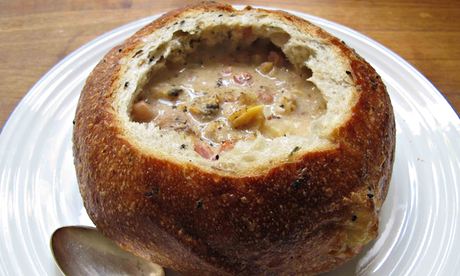
2kg fresh clams, scrubbed
500g large shrimp, peeled and deveined
250g scallops
250g pound fresh lump crabmeat
200g thick unsmoked bacon or pancetta, cut into small dice
1 onion, finely chopped
1 bay leaf
2 tbsp plain flour
2 medium waxy potatoes, chopped into 1cm dice
1/2 cup corn kernels, fresh or frozen
150ml double cream
Knob of butter
1/2 tsp paprika
1/2 tsp cayenne
Put the clams in a large pan with 600ml water. Cover, bring to the boil and steam until most are open, then pour into a sieve with a bowl underneath to catch the cooking liquid.
When cool enough to handle, remove from their shells and discard these. Roughly chop the clams, if large. Strain the liquid through a couple of layers of paper towel, or cheesecloth – you should have about 1.2 litres.
Meanwhile, heat a medium pan over a medium-high heat and fry the bacon in its own fat until this begins to render. Add the onion and fry until this is soft, the bacon is crisp, and both are beginning to brown. Add the bay leaf, cayenne, paprika and flour and cook, stirring, for a couple of minutes.
Slowly stir in the clam liquid, then add the potatoes. Simmer for 5 minutes and the corn and all of the seafood. Simmer until all the seafood is cooked and the potatoes are tender (about 10 minutes), then stir in the cream, clams and butter. Heat through, season to taste with plenty of black pepper and salt if necessary, and serve.
How to interpret a French wine label
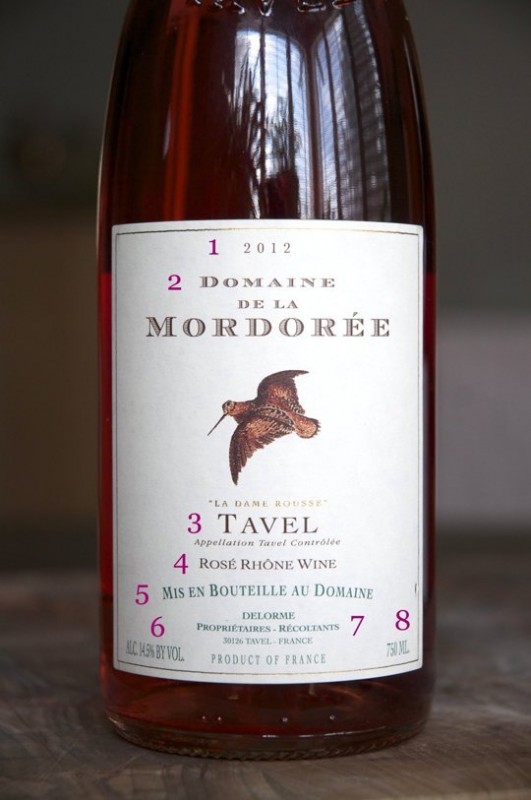
French Wine Label Basics:
1. Vintage
2. Producer
3. Appellation title or “sub-region”
4. Region and style
5. Translates as “bottled at the estate”
6. Alcohol content
7. Winery address
8. Volume
Now that we have covered the basics, let’s highlight some of France’s most prominent wine regions, the grapes grown there, and the styles of wine produced, along with specific regional phraseology.
Bordeaux
Located in the southwest corner of France, this region’s bold red blends, based around Cabernet Sauvignon and Merlot, are the benchmarks by which all other wines of this style are compared. Although there are dry and sweet white wines made primarily of Sauvignon Blanc and Sémillon, this is predominately a red wine region.
Primary Red Grapes – Cabernet Sauvignon, Merlot, Cabernet Franc, Petit Verdot, Malbec, Carmenere
General Style – full-bodied, dry, earthy red wines
The region is divided by the Gironde Estuary. The regions to the West, or “Left Bank,” of the river produce wines based upon Cabernet Sauvignon, while the regions to the East, or “Right Bank,” of the river produce wines based primarily on Merlot.
Major Left Bank Regions – Médoc, St. Julien, Pauillac, St. Estephe, Margaux, Graves, Pessac-Léognan
Major Right Bank Regions – Pomerol, St. Émilion
Burgundy
Located far inland near the eastern border of France, Burgundy is the one region equally famous for both its reds and whites. Comprised of dozens of small villages and vineyards that were sectioned off by the Cistercian monks hundreds of years ago, Burgundy is the most intricate vineyard land in the world.
Primary Grapes – Pinot Noir, Chardonnay, Gamay
General Style – elegant, light-bodied, dry reds and expressions of Chardonnay that range from steely and crisp to richly oaked.
There are five main sub-regions of Burgundy, each with its own distinct style. From North to South:
Chablis – crisp, generally un-oaked Chardonnay
Côte d’Or – further subdivided into two regions, the Côte de Nuits in the North (primarily Pinot Noir) and the Côte de Beaune in the South (primarily Chardonnay). This is where most of Burgundy’s top vineyards or grand crus are located.
Côte Chalonnaise – high quality reds and whites
Maconnais – good quality Chardonnay, most famously from Pouilly-Fuissé
Beaujolais – focused on the Gamay grape
Nowhere else in the world are single parcels and vineyards so prized as in Burgundy. The two highest levels of quality in Burgundy are based solely around single vineyard wines, emphasizing the distinct characteristics of that particular place.
Grand Cru – the 33 most famous single vineyards in Burgundy
Premier Cru (or 1er Cru) – over 500 single vineyards of exceptional quality
Village Wine – wines made from grapes surrounding a single village, where the village is actually the name of the wine (examples: Pommard, Mercurey, Rouilly, Volnay)
Bourgogne – wines made from any grapes grown anywhere in Burgundy
Alsace
Located in the far northeast corner of France, bordering Germany, this region has a long history of Germanic influence with respect to grape varietals, while the winemaking reflects a distinctively French influence. These are the easiest labels within France to understand: they are mostly labeled by grape varietal.
Primary Grapes – Riesling, Pinot Gris, Gewurztraminer, Pinot Blanc, Muscat
General Style – crisp, dry whites, with some delicious dessert wines
Alsace also utilizes a “grand cru” designation with over 50 of its top vineyards classified as such. Although most of the wines produced here are crisp, un-oaked whites, there are two tiers of high quality dessert wine, as well: Vendange Tardive and Sélection de Grains Nobles.
Rhône
Located in the southeast corner of France, the Rhône River flows through some of the country’s most diverse vineyard land on its way to the Mediterranean Sea. This is a region of extremes, from the searing hot regions in the Southern Rhône to the frigid windswept mountains of the Northern Rhône.
Primary Grapes – Syrah, Grenache, Mourvedre, Viognier
General Style – wild, gamey reds; rich, aromatic whites; and bone-dry rosés
The Rhône Valley is a tapestry of sub-regions, each with its own specific style and blending requirements. With a scorching climate, the sub-regions of the Southern Rhône are based around blending the grapes, Grenache, Syrah, and Mourvedre (GSM). The cooler temperatures of the Northern Rhône allow for single varietal wines of great purity, primarily Syrah for red and Viognier for white.
Major N. Rhône Regions – Hermitage, Cornas, Cote Rotie, Condrieu
Major S. Rhône Regions – Châteauneuf-du-Pape, Gigondas, Vacqueyras
Major Rosé-producing Regions – Tavel, Provence
Not to be confused with the Chardonnays from the Pouilly-Fuissé region of Burgundy, Pouilly-Fumé is made from Sauvignon Blanc grapes.
Loire
Located in the heart of France, the Loire is the country’s longest river. Draining from the Central Massif mountain range, the Loire river runs steadily west, passing through over fifty sub-regions on its way to the Atlantic. This is the most difficult region in France to learn, as virtually every possible style of wine is made here.
Primary Grapes – Cabernet Franc, Sauvignon Blanc, Chenin Blanc, Melon de Bourgogne
General Style – racy, herbaceous, mineral-driven reds and whites, as well as a large quantity of sparkling, sweet, and rosé wines
Similar to the Rhône region, the Loire is comprised of many sub-regions, each focusing on specific grapes and styles.
Dry, crisp Sauvignon Blanc – Sancerre, Pouilly-Fumé
Wild, savory Cabernet Franc – Chinon, Bourgueil
Fruity, dry rosés and high quality sparkling wines – Anjou-Saumur
Rich, yeasty Melon de Bourgogne – Muscadet
Dramatic Chenin Blanc, from sweet to dry – Savennieres, Vouvray
Last night’s dinner
I made tartiflette. It’s horrendously bad for you, but tastes sooooo nice :-)
